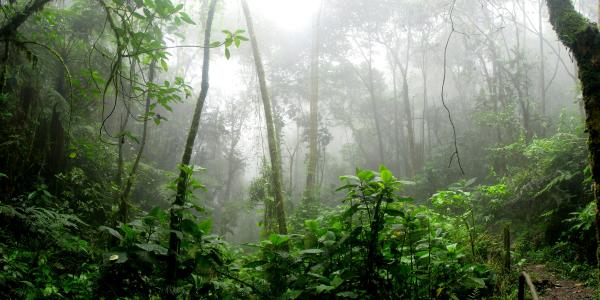A team led by researchers at WashU and the Missouri Botanical Garden uncovered the ecological forces that drive remarkable chemical diversity of trees in the Andes Mountains.
A new study led by researchers at WashU and the Missouri Botanical Garden has uncovered a surprising layer of diversity in tropical forests. Not only are the forests populated by a dizzying number of tree species, but each of those species takes a different approach to chemistry, increasing the array of natural compounds that provide important functions for the plants — and potentially for humans.

The research helped clarify the ecological and evolutionary forces that make tropical forests such hotbeds of biodiversity. While the team wasn’t specifically looking for compounds that could be useful for humans, their findings underscore the value of tropical forests as natural factories of plant chemicals that could have important uses in medicine and other fields, said Jonathan Myers, a professor of biology. “Tropical plants produce a huge diversity of chemicals that have practical implications for human health.”
The work was supported by the National Science Foundation (NSF) and the Living Earth Collaborative, a biodiversity initiative involving WashU, the Missouri Botanical Garden, and the Saint Louis Zoo. The study was published in the prestigious journal Ecology and led by former ecology and evolution biology graduate student David Henderson, PhD ’23. Missouri Botanical Garden researchers Sebastian Tello, Leslie Cayola, and Alfredo Fuentes; University of Texas at Austin chemical ecologist Brian Sedio; and University of Missouri–St. Louis ecologists Belen Alvestegui and Nathan Muchhala were also collaborators.
The researchers examined tree leaves collected as part of the Madidi Project, a large-scale survey of flora in the Madidi region of the Andes mountains in Bolivia. The team was especially interested in chemical compounds that plants use to help protect themselves from insect herbivores, pathogens, and other enemies — a top priority for anything growing in the warm, wet, and buggy tropics. They set out to better understand how these compounds differ among species that grow together in tree communities at low and high elevations with contrasting climates.
Using mass spectrometry, a technology that makes it possible to identify and count individual molecules in a sample, researchers uncovered a bounty of chemical compounds. “We identified more than 20,000 unique metabolites in leaf samples from 470 tree species,” Myers said. “It’s an amazing level of chemical diversity.”
More than a third of those compounds were terpenoids, a class of natural chemicals that plants use to fend off insects and diseases. As ingredients in pharmaceuticals, terpenoids have also shown promise in fighting cancer, relieving inflammation, and killing harmful viruses and bacteria. About one-quarter of the compounds were alkaloids, a class of plant chemicals that form the basis of many medicines, including pain relievers, anti-malarial drugs, and cancer treatments.
“With a global database of chemical compounds, researchers could look for unique chemicals that could have real value for society.”
—Jonathan Myers, professor of biology
The remarkable chemical diversity of tropical forests highlights the need to study and protect these biological hot spots, Myers said. He and his collaborators have contributed data from this project to help create a global database of chemical compounds identified from plants. “With such a database, researchers could look for unique chemicals that could have real value for society,” he said.
In the latest study, Myers and his team analyzed the diversity of tree species and leaf metabolites in wet and seasonally dry forest plots sampled at various altitudes ranging from approximately 2,000 to 11,000 feet above sea level. The higher they climbed, the fewer species they encountered. They identified nearly 140 different tree species in a single 1-hectare (2.5-acre) plot at an elevation of 4,000 feet but fewer than 20 species in a plot at nearly 11,000 feet.
As species diversity dwindled, so did chemical differences among tree species. High in the mountains, even trees from different species tend to use similar sorts of chemicals to protect themselves and cope with abiotic stress. The natural chemical factories only reach their full potential at lower elevations, Myers said.
In the super-diverse, hyper-competitive lowland tropical forests, it makes sense that a tree would employ chemical defenses that are completely different from its neighbors. “If a tree has the same chemistry as a neighbor, it could be vulnerable to the same herbivores and pathogens,” Myers said. Those enemies will do less damage overall if they have to search for different weaknesses for each tree, he explained.
The link between species diversity and chemical diversity extends beyond the tropics. Myers is part of an ongoing NSF project that studies trees at multiple locations, including the lowlands of the Amazon, the northern forests of Canada, and local research plots at WashU’s environmental field station, Tyson Research Center. Tyson’s expanses of oak, hickory, and other types of trees can’t match the diversity of tropical forests, but its trees are much more diverse than the coniferous forests up north. Laboratory tests have found that the trees at Tyson are also near the middle of the pack chemically: They’re not as abundantly productive as the trees of the tropics, but they are veritable treasure troves of unique chemicals compared to northern forests.
Climate could be the key to explaining why chemical diversity seems to go hand in hand with species diversity. Warmer, wetter, and more stable climates can support higher species diversity if plants limit the types of herbivores and pathogens that attack them by employing different chemical defenses, Myers said. “This could be one more way to explain the trends in plant diversity across the planet.”
Header image credit: David Riaño Cortés





